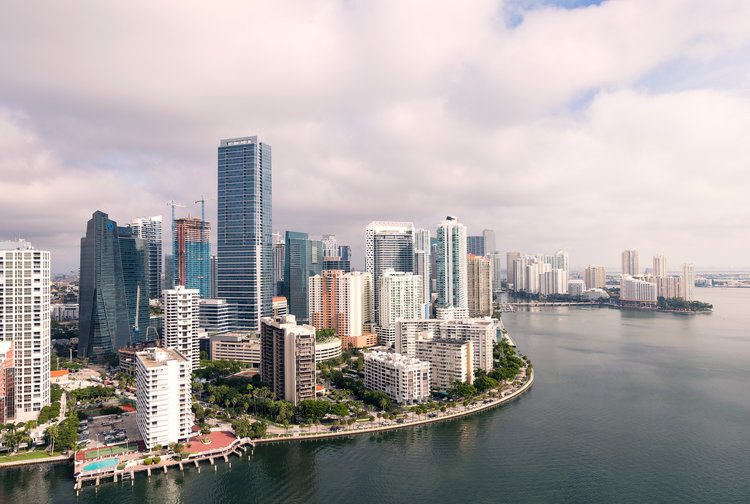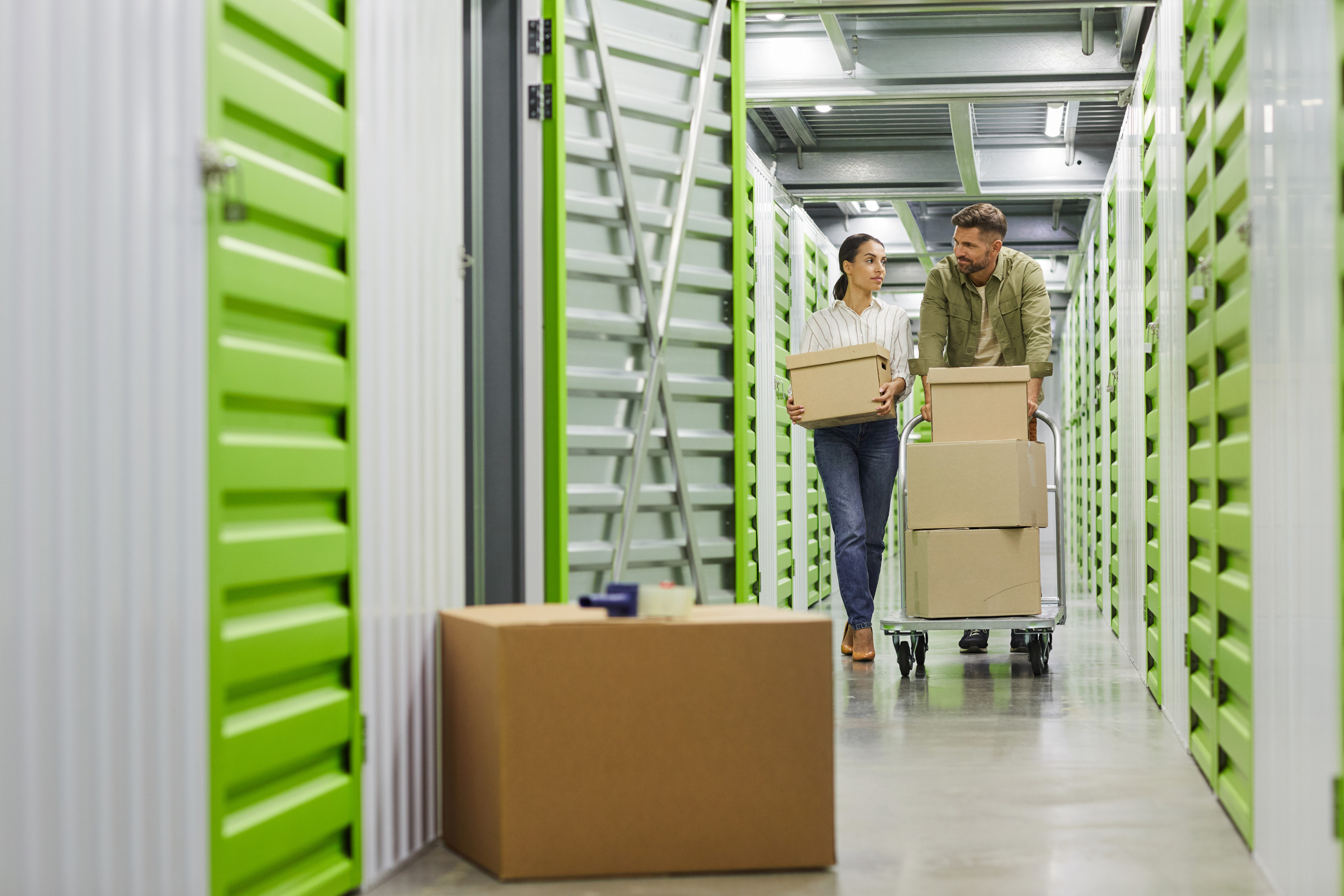Moving to Florida: Your Ultimate Guide

Moving soon? Get organized with our free moving checklist.
From beaches to art districts to stadiums, Florida has something for everyone. It’s no wonder Florida is now the third most populated state in the U.S. Whether you’re drawn to the low cost of living or are chasing warmer weather, you’ll have to do some research. Lucky for you, we did a lot of the work for you. From local school resources to DMV information, you’re about to be an expert on the Sunshine State!
- Finding Your New Home
- Cost of Living
- Employment
- Education
- Best Cities for Young Professionals
- Retirement Options
- Establishing Residency
Moving to Florida: Finding your new home
If you’re thinking about moving to Florida, you might want some general knowledge of the state. Here are Florida’s cities broken down by population. From Miami to Tallahassee, each one has its own unique flair.
Not sure which part of Florida to move to? Here are the top 6 places to live in Florida in 2022, including their populations and median incomes. While many think of Florida as being all beaches and tourism, the state is actually quite diverse. If you don’t have much background, you should read up on the state’s three main regions.
- Northern Florida: Northern Florida is home to thriving metro areas and natural attractions. Jacksonville, the most populous city in Florida and in the southeastern US, is in the northern part of the state. West of Jacksonville in the Florida Panhandle is Tallahassee, the 9th most populous city in Florida and ranked #2 for cities that gained the most residents in 2020. Tallahassee has the state’s largest university, Florida State University. If you move to Northern Florida, you can also avail yourself of outdoor attractions. These include parks like Wakulla Springs State Park and Manatee Springs State Park.
- Central Florida: Currently, Central Florida cities are among the fastest-growing in the U.S. At the top of this list is Orlando, the largest inland city in Florida. The Orlando region is also projected to add 1,500 people per week for the next 11 years! Coming in a close second is Tampa. Tampa is the third-largest city in Florida with a population growth of 1.7% in the past year and is still trending upwards.
- Southern Florida: Southern Florida may be the most iconic part of the state. If you’re looking for a bustling urban area, Miami is the second-largest city in the state. The city is also the most populous region in the Southern U.S. after Washington, D.C. Close to Miami is Hialeah, the sixth-largest city in Florida. Florida’s southern region also hosts the Everglades, providing unique natural attractions.
No matter what region suits you, moving to Florida comes with endless opportunities. The state currently has a 2021 growth rate of 1.25%. If growth continues at this rate, the population is expected to exceed 22 million by the 2021 census. This expansion will maintain Florida’s position as one of the most populated states in the U.S.

Moving to Florida: Cost of living
Many are drawn to Florida due to its low taxes. Take a look at the state’s taxes and current housing market — both are important factors to investigate before moving to Florida.
- Taxes: A large appeal to moving to Florida is its lack of income tax, a contributor to its ranking as the 13th best state to live in from U.S. News & World Report. The report also rated Florida second in the nation for fiscal stability and 9th for its economy in general. Still, the state has a sales tax of 6% and a hefty gas tax — ranking it 8th among the states with the highest gas taxes.
- Real estate: Although Florida’s housing market suffered from the 2008 recession, it’s rebounded nicely. Many cities in Florida have affordable housing options for both renters and homeowners. Still, prices in Florida’s major cities are steep. For example, Miami has a median asking price of $2,500 for a one-bedroom rental. One-bedroom apartments in cities like Tampa are a bit more affordable — which has a monthly average of $1,770.
If you’re looking to purchase a home in Florida, January is the best month to buy. While there are often fewer options on the market in January, you’re likely to save an average of $20,000 over buying a home in June. Some of the best Florida markets to invest in at the moment are:
- Pensacola (median home value: $145,800)
- Jacksonville (median home value: $177,500)
- Tallahassee (median home value: $183,400)
- Orlando (median home value: $241,200)
For more information on moving to Florida, explore the state’s real estate based on counties, cities, or zip codes.
Moving to Florida: Employment
Unless you’re moving to Florida to retire, finding a job is likely your top priority. Fortunately, Florida’s economic outlook is strong. As the population increases, job creation is vital to the state’s financial success. The state is currently the number one state in the Southeast for job creation, with 2.8% job growth in 2019 over the previous year. Additionally, Florida’s economy hit $1 trillion in 2018. Think of it this way, if Florida were a country it would be the 17th largest economy in the world!
Currently, Florida’s unemployment rate remains below the national average. With a rate of 2.7%, the state has the 14th lowest unemployment rate of all 50 states. If you’re moving to Florida and are still on the hunt for a job, don’t stress! There are a number of job search resources that will help you find employment in no time:
For those who are entrepreneurs, moving to Florida may be advantageous to your business’ success. According to WalletHub’s ranking of the states with the best conditions for starting a business, Florida comes in 6th out of all 50 states. Ranking factors include business environment, access to resources, and business costs. Outside of Silicon Valley and the East Coast, Miami is the third-best U.S. city to build a startup.
The hottest Florida job markets
If you’re looking to start or continue a career in Florida, you have many options, but, according to the Florida Economic Development Council, Florida is best known for the following industries:
- Aviation and aerospace. The Cecil Field Spaceport and the Cape Canaveral Spaceport are two of the nine operating spaceports in the United States. Additionally, Florida has the most active private sector launch permits with 8 out of the total of 17 licenses allowing companies to launch rockets into space being approved from Florida-based locations. With four launch licenses, Virginia is second. Additionally, Florida has one of the US’ greatest markets for aviation and aerospace technologies with more than 2,000 privately owned companies engaged in air and space flight-related activities.
- Life sciences. The life sciences industry in Florida is also expanding and innovative. Before hotspots like California emerged on the scene, the state was a national leader in innovation. Florida boasts 1,000+ pharmaceutical, biotech, and medical device businesses, as well as a foundation of more than 45,000 healthcare facilities, including 700 hospitals.
- Manufacturing. Florida’s biotech industries pride themselves on not importing their manufactured components and products. The state is one of the top 10 manufacturing states in the country with upwards of 18,200 manufacturers calling it home, employing more than 317,000 people. The industry manufactures a wide range of products including everything from tacos to rocket ship components.
- Security. Florida is a top destination for those in the security and defense sectors. Florida’s homeland security and defense industry continues to raise the bar on everything from cybersecurity to protecting ports of entry. Florida is also home to 20 military outposts.

Moving to Florida: Education
If you’re moving to Florida with children, you’ll want to look into schooling. Despite limited funding, Florida’s school system is solid. In fact, Florida’s public schools are third in the nation for K-12 achievement, based on a recent ranking of the country’s school districts. Fom public schools to charter schools to home education networks, there is surely an option that meets your family’s needs.
Take a look at Florida’s schools listed by the district to view K-12 public schools in particular areas. Some of the best school districts in Florida, based on factors such as safety and diversity, include:
- St. John’s County School District: Located in St. Augustine, Florida, St. John’s County School District ranks first on Niche out of 69 school districts in Florida. The district also ranks 2nd for best school districts for athletes and 7th for districts with the best teachers.
- Sarasota County Schools: Sarasota County Schools, located in Sarasota, is the second highest ranking school district out of 69 districts in Florida. It also ranks 1st for safety and 20th for diversity.
- Okaloosa County School District: Okaloosa County School District in Fort Walton Beach ranks third out of 69 school districts in Florida. The district also ranks 9th for best school districts for athletes and 12th for safety.
- Seminole County Public Schools: Seminole County Public Schools in Sanford is the fifth-best school district in Florida out of 69 districts. The area also ranks 2nd for diversity and 3rd for athletes.
- Martin County School District: Located in Stuart, Martin County School District is the seventh highest ranking school district out of 69 districts in Florida. The area also ranks 13th for districts with the best teachers and 8th for safety.
If you’re moving to Florida with hopes of pursuing higher education, you’re in luck! According to a recent ranking of all 50 states’ education systems, Florida has the best higher education system in the nation. The ranking was determined by the number of citizens that hold degrees, costs of attending college, student debt burden, and the time it takes to complete a two or four-year program. For more insight into Florida’s higher education system, take a look at the best colleges in Florida.
Moving to Florida: Best cities for young professionals
While Florida is a great place to retire, the state also has a lot to offer to young professionals. If you are moving to Florida post-grad, here are a few of the best communities to live in:
- Jacksonville – Believe it or not, Jacksonville ranks #7 out of all cities in the country for job seekers. Home to Fortune 500 headquarters and thriving businesses, Jacksonville is growing twice as fast as the rest of the nation. With 22 miles of beaches, vibrant nightlife, and the largest urban park system in the nation, the city also has plenty of leisure activities.
- Miami – Miami’s downtown is great for young professionals. Miami had four consecutive years of highly active apartment construction, totaling more than 50,000 new units between 2016 and 2020. As Millennials have aged, their share of Miami’s greater downtown population has greatly increased. In fact, in 2022 the millennial population in Miami outpaces that of the rest of Florida by over 7%. With a strong local economy, huge restaurant scene, and bustling beaches, Miami is perfect for those searching for an outgoing lifestyle.
- Tampa Bay Area – Another growing population in Florida, Tampa offers affordable homes in safe neighborhoods. The Tampa Bay area has plenty of urban attractions and is also home to 20 corporate headquarters with annual revenues over $1B, of which 8 are on the Fortune 1000 list. Check out Tampa’s best neighborhoods for young professionals in 2022 to see if the area is a good fit your you.

Moving to Florida: Retirement options
If you’re moving to Florida to retire, there are numerous active adult retirement communities. Should you prefer to purchase a home, Florida has many housing options that fall below the average home price in the U.S. It’s no surprise that multiple cities on Forbes’s best 25 places to retire to in 2022 are in Florida. Here are some of the top retirement destinations in Florida:
- Clearwater – Located on a barrier island in Florida’s Tampa Bay Area, Clearwater is known for its sunny weather and gulf coast beaches. With an average home price of $361,435, Clearwater’s real estate falls within the range of median home values in the U.S. The city also has a strong economy, good air quality, and a high number of doctors per capita — all positive factors to take into account when retiring to Florida. As an added bonus, Clearwater’s beach was named the number one beach in the US by TripAdvisor in 2021!
- Delray Beach – Just north of Fort Lauderdale, Delray Beach is a vibrant, yet intimate, town. With a median home price of $387,103, Delray Beach’s real estate is 9% higher than the median home value in the U.S. Like Clearwater, the city has a good economy and air quality — and abundant doctors per capita. If you’re moving to Florida with plans of retiring, Delray Beach is bound to provide an easy-going lifestyle.
- Palm Bay – Located southeast of Orlando on Florida’s Atlantic coast, Palm Bay is one of Florida’s best-kept secrets. The city has a median home price of $312,075, 13% below the national median. Palm Bay also has a secure economy and more doctors per capita than the national average. With sunny weather, golf courses, and nature trails, Palm Bay is a good place to retire for those looking to stay active.
Moving to Florida: Establishing residency
Once you’ve officially decided you’re moving to Florida, it’s important to take the appropriate measures to become a legal resident of the state. Here are a few logistics to take into account when moving to Florida.
- Declaration of Domicile. While signing a Declaration of Domicile is not mandatory, it is recommended. This document states that you plan on making Florida your permanent home and will comply with all requirements of residents of the state.
- Driver’s license and vehicle registration. If you’re moving to Florida from another state, you must update your driver’s license and vehicle registration information. To obtain a new driver’s license or register your vehicle, you’ll need to take a trip to the Florida DMV.
- Registering to vote. If you’re a U.S. citizen, registering to vote is a crucial step in moving to Florida. Once you move, you’ll need to update your voter registration records with your new address. You can change your information online, in person, or via mail.
- Setting up a bank account. If your current bank doesn’t have branches in your new city, you may want to consider switching banks. While online banking has simplified the banking processes, you may occasionally need to visit your bank in person. If you need a new bank, take a look at some of the best banks in Florida.

Are you set on moving to Florida? We don’t blame you! Read up on our guide to moving to a new city for more details. Now that you know all of the logistics, you can get started on the actual moving process. Don’t worry — we have tons of resources to guide you through that as well. Take a look at our ultimate moving checklist to get started.













